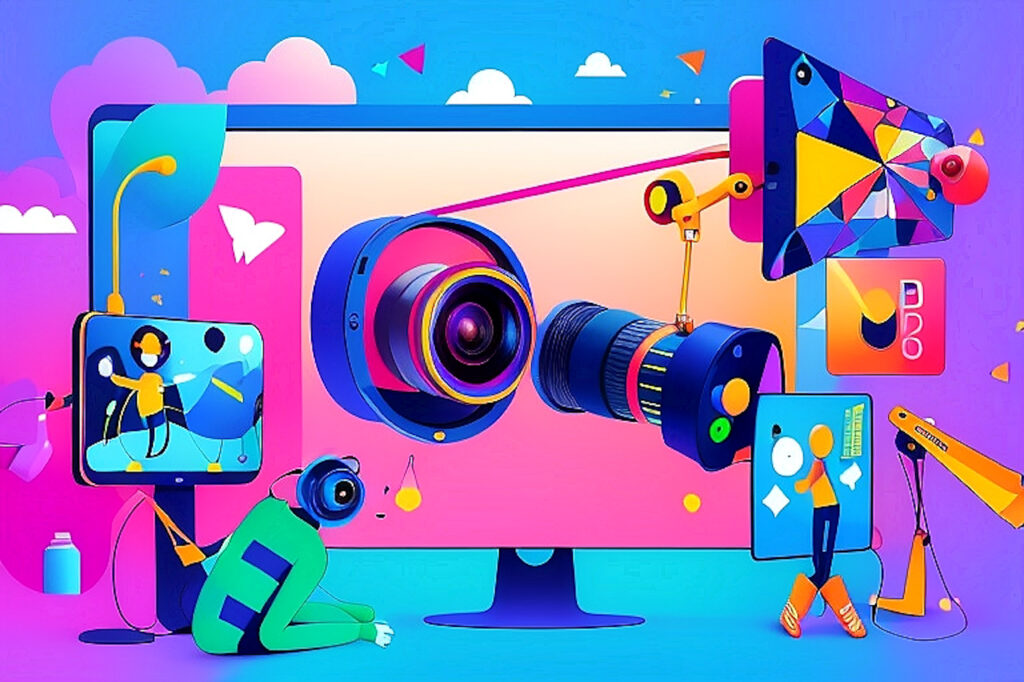
As an interested reader, you are probably aware that artificial intelligence is rapidly changing how videos are created. The AI video maker is now automating and assisting in many parts of the video creation process, allowing both amateurs and professionals to produce high-quality videos more efficiently.
This article offers an introduction to the key AI technologies transforming video production. We’ll look at AI applications for video writing, speech generation, character animation, editing, visual effects, and more.
Whether you want to create short social media videos, animated explainers, or full-length films, AI-powered software can help at all stages of production. Using these AI video maker and editor tools allows creators to focus their efforts on storytelling and creativity rather than the routine, mundane tasks involved in video creation.
Article Topics.
ToggleAI-powered video writing.
Writing an effective script is one of the most tedious parts of video creation. AI tools can help generate video scripts, outlines, and storyboards in a fraction of the time. Tools like Plotagon, StoryPix, and Wibbitz offer script and outline generation for various video formats like news reports, social media spots, and commercials.
You can feed these AI video creator tools just a basic topic or storyline and they’ll craft a complete script expanded into scenes and dialogue. The AI will customize the script to your desired length, tone, and format.
This automated approach to scriptwriting frees up creators to focus on high-level messaging rather than drilling down on exact wording.
AI-powered voice and speech.
Recording voice-overs and dialogue can be expensive and time-consuming if done manually. AI text-to-speech tools allow creators to automate the voice-over process.
Tools like Replica, Voicebot, and WellSaid Labs offer hyper-realistic text-to-speech. You can convert text from your AI-generated script into natural-sounding voice-overs in seconds versus recording hours of audio.
Some tools like Respeecher and Descript also allow creators to clone anyone’s voice using just short audio samples. This AI voice cloning opens up possibilities like making historical figures narrate educational videos or using the voices of celebrities and influencers without costly talent hiring.
In addition to automating voice-overs, AI can optimize speech patterns for clarity, engagement, emotion, and more. Tools like VocaliD craft natural cadences and inflection. This also helps to optimize audio pacing and emphasis for the best storytelling impact.
AI animation and character generation.
Creating custom animated explainer videos and shorts required extensive manual illustration and 3D modelling. Now AI tools can automate the character design and animation process to reduce production time and costs.
Platforms like Anthropic allow you to customize AI-generated 3D avatars with different faces, hair, clothing, and accessories. You just need to provide some basic direction and AI will handle animating natural expressions and movement to match the generated voice-over.
For 2D animation, tools like Toonify can transform video footage into cartoon or comic book style. Wombo Dream and Artflow.ai allow you to generate characters and scenes just by describing them in text.
Once custom animated characters are created, AI tools like Emotech can automate lip-syncing to make sure speech lines up with mouth movements.
AI video editor assistance.
Editing video can be extremely labor intensive, even using traditional software like Final Cut Pro and Adobe Premiere. AI tools aim to automate parts of the video editing workflow to reduce tedious manual work.
Tools like Runway and Descript provide auto-editing capabilities like slicing clips, applying transitions, and basic sequencing. While these AI video editors won’t make sophisticated creative decisions, they can execute routine editing tasks to build a rough cut from raw footage.
Other AI video editor assistant tools like Filmora give smart suggestions during editing like shot sequencing advice, color correction tweaks, and music recommendations. This allows human editors to work faster while maintaining creative control.
Some platforms like Imagen Video and Vochi even allow the generation of video edits from text descriptions. For example, you could describe the pacing, camera angles, transitions, and music; AI will assemble the edit based on the high-level direction.
AI visual effects and post-production.
Sophisticated visual effects once required specialized skills and lengthy rendering times. Now AI tools can quickly apply Hollywood-level VFX during the video editing process.
Platforms like Runway can add convincing effects like smoke, fire, explosions, lightning, and more with just a few clicks. Tools like Anthropic Studio and MetaHuman Creator allow easy generation of human-like 3D avatars for realistic digital crowds and backgrounds.
For post-production polish, AI systems can clean up low-quality or inconsistent footage.
Apps like Remini and Imagen Video use AI to upscale, de-noise, and enhance image quality. Tools like aiva.io and Descript leverage AI to master audio and optimize sound quality.
Future developments.
AI video software provides creators with an automated “extra pair of hands” throughout the video production workflow.
While human creativity is still essential, AI assists by taking care of routine technical tasks. This allows film-makers and marketers to develop higher-quality content faster and at lower cost.
As these AI video makers, editors, and assistant tools continue to advance, video creation will become more accessible to amateurs. However, there are still some limitations, like handling abstract creative concepts.
We are still in the early stages of AI’s potential to revolutionize entertainment and advertising. But this emerging wave of AI video generator tools provides an exciting glimpse of the future.

